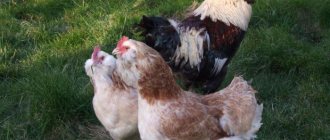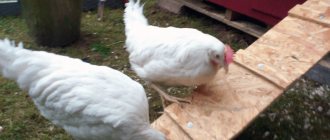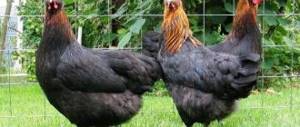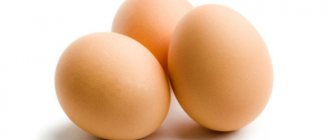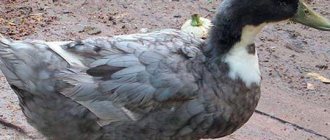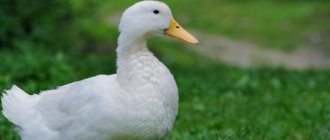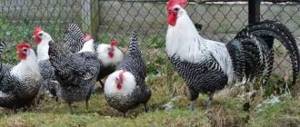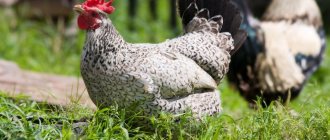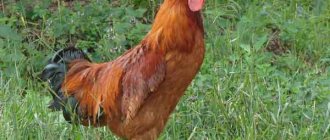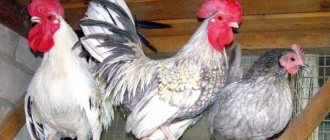Description and appearance of Brahma chickens, color
Brahma chickens, photos and descriptions of which may vary depending on the subspecies of the bird, have soft and thick plumage. It fits tightly to the skin, there is no looseness at all.
There are several options for plumage shades:
- red with fawn;
- yellow with red splashes;
- light blue with white splashes;
- white with grey, black, silver or brown tint.
Males have an ash or black “collar”, usually located in the lower part of the neck. If the color of the bird is dominated by light colors, then upon visual inspection dark feathers are found in the area of the tail and mane. Males and females have strong, powerful lower limbs. The feet are set high and covered with yellow feathers. The beak is yellow, small, but strong. The head is crowned with a comb with three inconspicuous teeth. The forehead of chickens and roosters is wide. The neck is of medium length, with close-fitting feathers forming a mane. The back of the head is flat, the head is small.
The body is massive: birds of this breed have a wide back and chest. The tail is lush, the plumage on it is bright. Despite their large wings, Brahma roosters and hens cannot fly, so trimming their feathers is not necessary. Their eyes are bright orange, earrings and earlobes are red.
History of the origin of the Brama chicken breed
Brahma chickens were bred in America at the end of the 19th century. At that time, Indian ruffed chickens were introduced into the country, whose impressive size captivated the Americans. It was then that they got the idea to create something similar in their homeland. Breeders took two breeds as a basis - the Malayan fighting breed and the Vietnamese Cochin for meat production.
In 1874, a new breed of Brahma chickens was registered. At that time, these birds were highly valued for their excellent meat qualities. The average weight of a rooster reached 7 kg. The birds could barely stand on their feet. Since then, the breed has undergone changes - the current breeds are no longer so well-fed, since broiler breeds have taken the leading role in poultry farming. Now these chickens are bred as ornamental chickens.
Interestingly, at first this breed line had a different name - Chittagong, but in 1952 it was renamed Brahmaputra. Over time, in America, and then in Europe, the abbreviated name – gate. By the beginning of the 20th century, these chickens had spread throughout most of Europe. They were also popular among Russian poultry breeders, along with Cochins, Orpingtons, Plymouthrocks and Faverolles.
Bird temperament
Brahma chickens (photos and descriptions are presented in the article for informational purposes) are quite calm in nature. They do not show aggression towards representatives of other breeds, preferring to remain neutral. According to reviews, a small area is enough for females and males of Brahma to live comfortably. Representatives of this breed are hardy and unpretentious. Chickens and roosters do not show fussiness and do not enter into open conflicts with ducks, geese and other birds.
They are resistant to low temperatures and can adapt to any weather conditions.
Brahma chickens
Brahma is a beautiful, very large, hardy bird with a calm, friendly character. The impression of strength is created due to the outstanding height and massive, very broad, but not too deep figure, a magnificently feathered body with magnificently feathered legs. An important posture and fearless appearance reinforce this impression.
Adapted to damp, cold climates. Despite their impressive size, they are content with a small walk. Chickens have a well-developed brooding instinct. They begin to lay eggs at 7-8 months. The average egg production under normal growing conditions is 120 - 140 eggs per year weighing 55-65 g (for young chickens 50-55 g, for old ones up to 65-70 g).
This beautiful breed is supervised by a Special Union, which consists of 15 board members. In 1992, at the German Young Bird Show, held in Hannover, Brahma earned the “Golden Winner’s Ring.” In Russia it is quite widespread among amateurs, but, unfortunately, there is a wide “diversity” due to insufficient breeding work and uncontrolled mating with other breeds.
Varieties
The breed is classified by color.
There are several main types:
- dwarf;
- European decorative;
- Asian decorative meat;
- American meat.
Chickens Brahma.
Varieties of coloring. Brahma chickens (photos and description of species):
| Name | Description | Photo |
| Dark | Dark colors dominate the color. The pattern is blue-black stripes forming a crescent. The head and neck of birds of this species are silvery. White feathers are edged with black. The beak of chickens and roosters is yellow and strongly curved. The legs are powerful, the feathers on them are yellow. | |
| Light | The color of this species is dominated by light shades. Chickens and roosters have a white (less often silver) back, chest, wings and paws. The tips of the tail feathers are black with a blue tint, and there are stripes of the same color on the neck. The head is usually white. | |
| Fawn | Males and females of this species have plumage ranging from creamy brown to bright copper. Roosters are larger than chickens and their feathers are more intensely colored. Black color is present on the wings, tail and neck. | |
| Kuropchataya | The tails of roosters and chickens of this breed are bright, with a green metallic tint. The wings and neck are copper-brown, the chest and back are dark green. The plumage of chickens is more uniform. |
Any other shades present in the bird’s plumage allow breeders to consider the individual to be defective. All varieties have high productivity.
External features
Representatives of the breed can be easily distinguished from other chicken varieties by the presence of abundant feathering on their paws (up to the toes), due to which their gait is leisurely and cautious - “majestic”. This fact is explained by the fact that the birds were originally bred to be kept in cold climates.
The main distinguishing feature is the presence of feathers on the paws right up to the toes.
Brams have a “proud” posture and massive constitution, especially males, which are much larger than females. The birds have a strong, fleshy build, a dense, short and wide body, long and thick legs. The head is quite small, with a wide forehead, a short yellow beak and a small pod-shaped crest. Roosters have more magnificent and spectacular plumage, a tail with short braids and a well-defined mane.
The birds have a calm character, they are easily tamed, and get along well with all their neighbors in the poultry house and yard. Roosters rarely start fights, and chickens are generally very peaceful, and they are also excellent hens.
Plumage color options
Based on the color of the plumage, several subtypes are distinguished, formed during the breeding process:
Light This subspecies is also called Colombian. The main color is silver-white. In adult females, the upper feathers of the tail and wings are black. There is a dark stripe on the neck that looks like a collar.
The light or Colombian subspecies is one of the most common
Currently, new variants of the light subtype have appeared, for example, with a white-blue color. White birds have feathers on their tail, wings and mane that are not black, but have a blue tint.
Dark The dark brahma's plumage color is mainly gray-brown. The body of the chickens is decorated with a complex pattern of dark semicircular stripes, which are located along the contour of the feather.
The plumage of female individuals of the dark subspecies has a complex pattern
Males have a different color: almost completely black with a greenish tint, and there are white feathers on the collar and back.
Birds of both sexes of this subspecies have a reddish-brown color with a pronounced dark “collar”. The plumage, although lush, is quite loose, so the birds sometimes look a little disheveled. The light fur on the paws resembles short pants.
In the photo - fawn-colored Brama chickens
Partridge The plumage of females is light fawn with a complex speckled gray-black pattern. Males are much brighter and have a combination of colors: fiery red feathers on the head, collar and back, combined with black (with a dark green tint) on the chest, belly and legs.
Partridge is one of the most decorative varieties of the breed
Advantages and disadvantages
Brahma chickens, photos and descriptions of which are presented in the article for your reference, have many advantages over other egg and meat breeds. Beginning breeders are advised to familiarize themselves with the pros and cons of breeding.
The benefits include:
- Decorative appearance. Chickens of this breed are sometimes bred in summer cottages for decoration. Bright plumage and attractive appearance are considered an advantage of the breed.
- Good-natured character. Representatives of this breed are tolerant of their “neighbors.” They can be placed in a small area without fear that crowded conditions will affect egg production.
- Productivity. Brahma chickens lay eggs all year round. The eggs are large, hard-shelled, and have excellent taste. Their meat is tender and juicy. The bird gains weight quickly.
- Unpretentiousness. Representatives of this breed do not require special care. Breeders just need to choose the right diet and carry out a number of preventive measures to prevent the development of a number of pathologies.
- Strong immunity. Representatives of this breed have high vitality. Chicks are born (whether naturally or through an incubator) quite hardy.
Disadvantages include the high cost of adults and chicks. Some breeders consider a phlegmatic character to be a disadvantage - the bird cannot stand up for itself. Open conflicts with chickens and roosters of other breeds can provoke serious injuries to Brahma (fractures, ruptures of the skin, accompanied by bleeding).
Breeding Brahma chickens in a private farmstead
To breed this breed, eggs are taken from chickens in their second year of life. It is best to use an incubator, since brood hens, although they have a good brooding instinct, often crush eggs. Those who prefer to buy young animals are advised to quarantine the chicks for a period of 3 weeks. If the chickens are infected with any infection, during this time the problem will become apparent.
Reference. Chicks hatched later than June do not have time to get stronger before the onset of winter; their bodies are less resistant to diseases.
In Russia, purebred Brahma chickens are almost never found, because chickens are crossed with Cochins, and within the breed there is a mixture of varieties. Dark and silver frames are popular in our country.
For many poultry farmers, this breed has become a favorite; they breed Brahma chickens of different colors as ornamental meat birds. The birds provide farmers with tasty meat and a small amount of eggs. Russians value these birds for their calm disposition, good adaptation to the local climate, unpretentiousness and external beauty.
Breed characteristics
Initially, Brahma chickens were bred for meat. Their body weight exceeds the weight of egg crosses by almost 1.5 times. Laying hens have a well-developed maternal instinct: the hen not only hatches, but also raises the chicks.
Sexual maturity and onset of oviposition
The hen lays eggs after more than 75% of her weight has been gained. At this time, puberty begins. The musculoskeletal system of the individual is fully formed, which allows the female to spend mineral reserves on the formation of the shell, white and yolk of the egg. Meat crosses begin to lay eggs at 7 - 8 months.
The onset of egg laying can be affected by a number of conditions:
- Selection of diet. The supply of minerals necessary for the formation of an egg is gradually depleted, so charcoal and shells must be added to the bird’s feed (in addition to grain).
- Equipment for warm nests. In order for egg laying to begin on time, the bird needs to equip a nest and place it in a spacious, dry and dark place.
- Adding vitamins. Various mineral complexes help accelerate egg laying. If the bird regularly receives vitamins, then it can begin to lay eggs 14 - 15 days earlier than expected.
- Absence or presence of stress. The individual experiences discomfort when exposed to loud sounds or systematic temperature fluctuations. Chickens are quite shy, so they need to be provided with peace and quiet during the laying period.
- Time of appearance. If the chicken hatched in early spring, then egg laying can begin at 9 or 10 months of life.
The Brahma meat breed of chickens does not lay eggs every day. Performance decreases as the bird ages. Most often, the livestock is changed every 1.5-2 years.
Stopping oviposition and beginning of molting
Molting is a natural process during which egg laying stops. Most often, plumage renewal takes place once a year. Shedding begins in late summer (August) or mid-autumn (October). Birds begin to lose feathers first on their head and neck. Then small bald spots will appear on the hips, sides, back and tail. After molting, the plumage will become softer and denser, the hens will be reliably protected from temperature changes, moisture and wind.
Relatively young individuals (no older than 12 months) change their plumage in 3-3.5 weeks, provided that they receive enough vitamins and minerals with food. Individuals whose age exceeds 2-3 years molt within 45-60 days. Shedding is a painless process. There are no nerve endings in the feathers, so the chicken does not experience any discomfort. During the molting period, the bird's reproductive system is not able to properly form an egg, so chickens do not lay eggs at this time. To avoid stressful situations, you must refrain from touching the bird.
New individuals (chickens, young animals) are not placed in the chicken coop. Any stressful situation can increase the shedding time. If an individual is attacked by its relatives, then it is best to temporarily isolate it. It is recommended to monitor the humidity inside the chicken coop and avoid drafts. To strengthen the immunity of chickens and roosters, you can add apple cider vinegar to the water (1 tablespoon per 5 liters of clean water).
Productivity
Brahma chickens gain weight quite quickly. Males are larger than females: adult roosters weigh up to 4.5 kg, chickens - 3.3.5 kg. The beginning of oviposition occurs at 8-9 months of the female’s life. During the year, the chicken lays up to 140 eggs (2-3 eggs per week) with a dense white or cream-colored shell. It may contain dark inclusions. The taste of the eggs is excellent (consumer rating – 8 points out of 10). Average weight is up to 60 g. As individuals age, the productivity of individuals decreases: the meat becomes fibrous and tough, chickens lay eggs no more than 1-2 times a week.
Males in the 4th year of life become passive, losing interest in females.
Dynamics of growth and weight gain
Experts recommend regularly monitoring the weight gain of chickens and weighing them every 3 to 7 days. At 1 month of life, 80-85% of energy is spent on growth, the remaining 15-20% is spent on maintaining the vitality of the body. Chicks gain up to 10-15 g per day. A newborn chick weighs 30 g.
Gain by week:
- 1 week - 100-110 g;
- 2 week - 170 - 180 g;
- 3 week – 250-260 g;
- 4 week – 340-350 g;
- 5 week – 420-430 g;
- 6 week – 500 – 510 g;
- 7 week – 580-600 g;
- 8 week – 670-680 g;
- 9 week 750-760 g;
- 10 week – 830-840 g;
- 6 months – 1400-1500 g;
- 12 months – 2000-2200 g;
- 18 – 24 months – up to 3500 g.
Chicks need to be weighed one at a time. The weight of the container (plastic pallet, cardboard box) is known in advance.
Feeding
The breed needs a complete diet without overfeeding due to its tendency to obesity. It is necessary to add feed protein, milk powder, eggs, cottage cheese, fish meal, and vegetables (carrots, cabbage) to the grain mixture for young animals. It is recommended to feed Brahmins 1 to 3 times daily, combining dry and wet food. In winter, the share of grain in the diet increases to 15% to generate additional energy for heating the body.
- Stern
- Recipes
- Supplements
Compound feed pk-1
Description of food for egg breeds. Instructions for feeding laying hens
Read
Compound feed pk-2 and pk-3
Mineral and vitamin compositions, feeding standards
Read
Compound feed pk-4
Used to feed laying hens aged 15-17 weeks
Read
Compound feed pk-5
Composition and instructions for feeding broiler chickens
Read
Purina® Pro
Important differences from the previous line, application patterns Start, Growth, Finish
Read
Barley and wheat for laying hens
Germination and steaming of barley and wheat for chickens: how to do it correctly and how to give it to laying hens
Read
Wheat for broilers
Rules for feeding broiler chickens with wheat. Dosage for chickens from the second day of life and adult birds
Read
Mash
Making mash for broilers at home
Read
Rice and buckwheat
How and in what form you can use rice and buckwheat to feed chickens. Standards for adult birds and chickens
Read
Bread
What kind of bread can you feed chickens and how to do it correctly
Read
Fish
The product is given in limited quantities: overfeeding can cause serious harm to the bird
Read
Chalk
Chalk as a food additive for chicken feed. Feeding standards for chickens, young animals and laying hens
Read
Meat and bone meal
Meat and bone meal is a mandatory additive for feeding chickens, containing protein and fats of animal origin.
Read
Fish fat
How to give fish oil to chickens, layers and broilers. What are the benefits of the drug and are there any contraindications?
Read
Limestone
Limestone (dolomite) flour in the diet of chickens. Advantage over chalk and feed shell
Read
Salt
Daily dosage of salt for adult birds and young animals and cases of unwanted use
Read
Bird breeding. Rules, features, recommendations
Despite the fact that representatives of the Brahma family are quite unpretentious, it is necessary to adhere to a number of recommendations in order to raise a healthy bird:
- One-day-old chicks grow quickly, so it is important to provide them with proper balanced nutrition. As they grow older, their paws elongate and become overgrown with fluff.
- It is not recommended to keep chickens of this breed in the same coop as broilers. In this case, the risk of delays in weight gain is quite high.
- For breeding, it is best to buy chickens born in mid-spring (April).
- Young animals are transferred to a common chicken coop at the age of 6 months. They can be kept with other breeds.
According to reviews, Brams born in an incubator lack maternal instinct and rarely sit on eggs. You can return this ability to the offspring by crossing a laying hen with a rooster of any other breed or rhodonite.
Breeding Features
For breeding, it is recommended to buy individuals from one to 3 years old. Chickens reach sexual maturity at 9 months of age. Around this time, the hen instinct awakens in birds. It is especially developed in light-colored representatives of the breeds. They hatch eggs well and carefully take care of their offspring.
The hen should be planted or the eggs should be incubated from mid-February to April. During this period, hatched chicks will have time to become sufficiently strong, fledge for winter and calmly endure low temperatures.
After birth, Brahma chickens need a heated and well-lit room and fortified food. For chicks up to 2 weeks old, broiler starter feed is suitable.
Content Features
The growth and productivity of Brahma chickens may depend on the characteristics of the keeping. The bird needs to be equipped with a clean chicken coop, a walking area and a balanced diet. Despite the fact that chickens have dense plumage, they require a warm room in winter.
Poultry house requirements
The room allocated by the breeder for the poultry house should be spacious and bright. Before settling with birds, it must be treated with an insecticide. The walls and ceiling are sprayed with the solution, then the room is ventilated. You can let the bird inside 48 hours after treatment.
The main “components” of a chicken coop:
- Perch. A must-have element that should be present in every chicken coop. In order for the bird to sit comfortably on it, it is necessary to select the “right” poles. They should not be too thick or thin, otherwise the bird will not be able to wrap its paws around them or the pole will break under the weight of the chicken. To make a perch, use timber (section 5x6 cm). To prevent splinters from getting into the bird's paws, the protrusions are sanded with sandpaper. Poles can be made from shovel cuttings.
- Nests. For comfort, birds are equipped with nests in special places. You can make a structure from metal pipes of small diameter, cover them with sheets of plywood, forming boxes. You can lay straw on the bottom. If the nests are located high, then you need to lean a ladder against the structure. The depth of the nest is 40 cm, the height and width are 30 - 35 cm. The box should rise 50 cm from the ground.
- Feeders. The structure can be made independently from pre-polished boards. It is not recommended to spill food on the ground: stones, glass fragments and other foreign objects may get into the bird's stomach.
- Drinking bowls. They can be purchased at a specialty store. The water in the drinking bowls is changed several times a day, monitoring the temperature. Clean them 1-2 times a month, you can use disinfectants or soap solutions.
The room should be well ventilated. For convenience during construction, breeders provide ventilation inside the house. It is also important to monitor the lighting: if there is not enough light inside the room, additional artificial sources are installed. The floor is covered with wood shavings - this will provide additional warmth during the cold season and minimize the risk of injury to the paws of chickens and roosters.
Walking requirements
A walking area is set up next to the chicken coop. The shorter the distance between the pen and the poultry house, the better. The area of the walking area directly depends on the number of individuals. The pen is set up on the grass and fenced with a net. The height of the “walls” should be 1.5-2 m. To protect the brood from rain, you can equip a canopy. It is recommended to install feeders and drinking bowls inside. Birds are not left in the pen overnight.
Conditions for winter
Despite the fact that Brahma chickens have dense plumage, experienced breeders recommend insulating the house before winter. The optimal temperature varies in the range of +12 - +14°C. If the bird freezes, productivity decreases sharply. Any thermal insulation work starts from the floor. Sawdust, wood shavings, straw or peat can be used as material. To create a temperature above 25° C, deep bedding is laid. Fur peat is characterized by absorbent properties: it quickly absorbs droppings and moisture.
In a poultry house whose floor is insulated with this material, there is no unpleasant odor, and the birds are reliably protected from skin diseases (including dermatitis). In spring, you can fertilize the beds with peat. Straw is the most popular material among poultry farmers. It retains heat for a long time. The thickness of the straw on the floor should be 20-22 cm. As it is used, the material is trampled down and its thickness decreases. To maintain the temperature regime, add 10 cm of straw to the floor once a month. You can lay dry grass on top for softness.
Before insulation, it is important to inspect the material for mold. Sawdust is poured in a thin layer onto the flooring. It is preferable to use shavings of coniferous trees: they contain essential oils, the evaporation of which has a beneficial effect on the bird’s immunity. The walls are insulated with mineral wool, penoplex or polystyrene foam. To prevent birds from freezing in winter, you can install an additional heating system, for example, infrared lamps.
Feeding hens
Brahma chickens (you can study their varieties using a detailed description and photo), like any other breed, need to organize a proper diet. Minerals and vitamins must enter the body with food.
A balanced diet should include:
- ready-made feed;
- dry and wet food;
- solid food (vegetables);
- grain mixtures and cereals.
The most important aspect ensuring high productivity is the presence of additional elements in the diet. They allow you to balance minerals, vitamins and ensure the harmonious development of the individual.
Daily feed intake:
- various mineral supplements - 5-6 g;
- bone meal - 2-3 g;
- high protein food - 12-15 g;
- solid, juicy food - 40-50 g;
- fortified hay flour - up to 10 g;
- flour mixture - 50 g;
- grain - 50 g.
There are several main types of food:
- Feeding. It contains minerals and vitamins.
- Wet. The mixture consists of boiled, raw vegetables combined with herbs, cereals or bran.
- Dry. The mixture includes grains and cereals.
In veterinary pharmacies you can purchase ready-made feed with a balanced composition. It not only normalizes appetite and ensures the normal functioning of the digestive tract, but also affects the immune system, increasing the defenses of the bird’s body.
Caring for young animals
Young animals are moved to adults at the age of 2 months. If chickens grow up without a laying hen, they need to create comfortable conditions. The room where young animals are kept must be clean and warm. At 10 days of age, the chickens’ feet are wiped with alcohol. The water in the drinking bowls is changed every 2 hours. The place where the young birds spend the night should be dry: small chickens can be collected in a large cardboard box.
Nutrition of growing birds
Young animals include chickens aged from 10 days to 4 months. Grown-up individuals must be fed boiled eggs, dairy products, dry and liquid food. You can add greens. Dairy products and eggs contain proteins that are necessary for muscle development and the production of digestive enzymes. Dry food is introduced into the diet gradually at the age of 8-10 weeks. Brahma is considered a meat breed of chickens, so chickens, starting from 6 days, are given cottage cheese or yogurt. You cannot feed them fresh milk.
Feed rates (% of total weight):
- feed yeast - 2%;
- feed fat - 2%;
- chopped boiled potatoes - 15%;
- fresh chopped herbs - 5%;
- feed chalk – 1%;
- meat and bone meal - 15%;
- ground corn grain - 50%.
From the age of one month, chickens can be given earthworms or bloodworms - this is an additional source of micro- and macroelements.
Maintenance and care
The bird does not require special conditions; the breed is hardy and unpretentious, but it takes a lot of work to raise healthy and beautiful individuals.
Chicken coop equipment
To maintain pure breeding, Brahma is kept separately from other chickens. The requirements for the chicken coop are as follows:
- Individuals are of impressive size. The chicken coop should be spacious with strong perches and nests (height from the floor no more than 35-40 cm, width no less than 30 cm). Each chicken has its own place to rest.
- The plumage of birds allows them to withstand frost, but it is important to protect the room from freezing and drafts.
- The floor is covered with straw or sawdust. The ideal option is a concrete covering. In winter, the layer of litter is at least 10 cm, in summer – 5-6 cm.
- Secure strong feeders and drinkers. It is best to screw them to the walls, so the chickens will not get the feathers on their feet wet, and debris will not get into the food.
- For stable egg production, the duration of daylight should be at least 12 hours. Lighting is installed in the chicken coop and window openings are installed.
- For birds of this breed, free range is important. Individuals are prone to obesity and need physical activity.
- A mandatory condition is the presence of containers with ash for bathing.
- Airing and cleaning are carried out regularly, feeders and drinking bowls are cleaned, and bedding is changed.
Maintaining cleanliness is a must. Otherwise, the plumage will look untidy.
Proper nutrition
They use high-quality balanced food, rich in vitamins and microelements. Three meals a day according to the schedule are required. They use grain crops, fodder vegetables, fruits, seeds, berries, herbs, table waste (flour products, fish, meat, cereals). Some of the food is sprinkled on the floor so that the bird collects it and moves.
It is important to add vitamin complexes, chalk, bone meal, fish oil, soybean meal, and eggshells. There should always be crushed shells and river sand in a separate container.
Free-range chickens eat worms, beetles, insects, plant seeds, and herbs.
In case of sudden weight gain, proteins and carbohydrates are removed from the diet and more plant foods are introduced.
Diseases
Despite its strong immunity, the breed is susceptible to a number of diseases:
- Helminthiasis. The invasive type of disease occurs when worm eggs enter the digestive tract of a bird. Treatment is carried out with anthelmintic medications. Deworming is recommended every 3 months.
- Scabies mite. The parasite penetrates under the scaly plates located on the bird’s feet and into the feather follicles. The disease is accompanied by an aggressive condition, itching leads to partial or complete loss of feathers. Drug therapy includes the use of acaricidal drugs.
- Period. The disease provokes the development of itching. The skin parasite can be seen on the body with the naked eye. For treatment, insecticides designed to combat ticks and fleas are used.
- Neuritis. The causative agent of this pathology is considered to be the herpes virus. The disease can occur in classical and acute forms. Type 1 is characterized by paresis, lameness, and paralysis. For form 2 - exhaustion, decreased egg production and tremor. The virus is stable in the external environment; there is no specific treatment.
- Leukemia. An oncological disease characterized by necrosis of the ridge, exhaustion and decreased egg production. A tumor forms under the skin in the chest area.
- Coccidiosis. A parasitic infection caused by a protozoan organism. Chickens are at risk. The incubation period of the pathology is 4-5 days. Symptoms: loss of appetite, depression, thirst, unkempt appearance (bald spots, drooping wings). Drug therapy includes taking coccidiostats.
- SSYA-76. A viral type pathology that affects the genitals of laying hens. The female's body is not able to form an egg - the shell becomes soft. There are no characteristic signs. Associated symptoms include diarrhea and prostration.
- Pasteurellosis. Infectious diseases cause sudden death in chickens. If the disease is acute, the individual’s earrings and comb turn blue. The pectoral muscles completely atrophy, foam appears from the beak. The bird is thirsty. Chronic pasteurellosis is accompanied by rhinitis and inflammation of the jaw.
- Salmonellosis. The main manifestation of the pathology is liquid, foamy droppings. The bird becomes lethargic and experiences extreme thirst. Possible swelling. Chickens are at risk.
- Listeriosis. The causative agent is a gram-positive rod. Characteristic manifestations of the pathology are convulsions and conjunctivitis. If left untreated, the bird becomes paralyzed and dies.
Any ailments or changes in behavior are a reason to contact a veterinary clinic. A number of pathologies cannot be detected without laboratory testing.
Price
It is recommended to purchase hatching eggs, chicks, adult hens and roosters from experienced breeders. Their cost varies depending on the gender and age of the individual.
Approximate prices:
- eggs – 40-80 rubles/piece;
- chickens (up to 2 months) – 150-300 rubles/piece;
- adult roosters and hens – 450-750 rubles/piece.
Compared to roosters, laying hens are more expensive. Before buying, you need to carefully examine the bird: nondescript plumage, dilated pupils, stuck together feathers in the tail area may indicate the development of the disease. Brahma chickens, as a separate breed, are popular among farmers. The photo may not always match the description. A slight defect in the plumage will not affect the taste of the meat. Usually the cost of such individuals is much lower.
